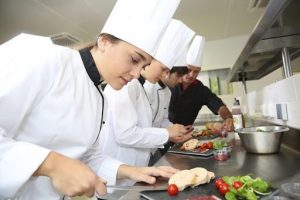There are various components of chef uniforms for restaurants, each of which plays an essential part. Each uniform has a specific purpose, from protecting food from contamination to denoting seniority in the chef hierarchy. In every profession, some recognizable elements reveal what type of work people do. You recognize a police officer by their badge and hat. Similarly, a chef’s uniform lets you know that someone works in a professional restaurant.
Probably the most noticeable element of the chef’s uniform is the coat. The chef’s coat helps to identify which individual in the kitchen is in charge. The white chef’s coat is well known because of the dignity and rank wearing a solid white coat. It helps this person stand out in the kitchen and is a mark of professional education and training. In other words, the chef’s coat also helps protect them from kitchen hazards, including splashes from hot liquids and burns. If you are still unclear why chef uniforms are necessary, get up to speed by considering the factors below.
Table of Contents
Professionalism:
If you want to be identified as a professional in your industry, you have to dress like one. This is a hard concept for a few people to grasp as they think the old saying of “the clothes make the person” is superficial and outdated. Restaurant’s diners don’t get the luxury of getting to know you over a long period of time. They only have a few minutes to determine if you are a person they can trust with their meals. Chef uniforms for restaurants convey a message of professionalism because uniforms indicate you are serious about your role enough to invest in the proper uniform. At its most basic, professionalism is about focus and seriousness; chef uniforms send out this message loud and clear.
A well-functioning restaurant is the product of team effort. From the chef to the dishwasher to the busboy, everyone must know their roles and do their roles well for the restaurant to run smoothly. Chef uniforms refer rank, and this helps ensure everybody keeps to their roles. Just as a military service with a unified uniform will quickly devolve into insubordination and confusion, a restaurant without chef uniforms and support staff apparel can quickly get chaotic, especially as orders flood in. Chef uniforms convey rank and rank establishes order. If you want a smooth-running restaurant where everybody sticks to their part, invest in the right uniforms.
Recognition:
Chef uniforms are essential when it comes to maintaining or establishing your restaurant’s brand. In the food industry, you need to use every bit of leverage you can to stay ahead of your competition. By having your company logo embroidered on your custom-made chef’s uniforms, you help brand your restaurant. This is crucial when making public appearances or leaving the kitchen to greet diners and restaurant supporters.
Different Roles of Chef Uniform:
- Chef jacket: The chef pants help to prevent contaminants from everyday clothes from contaminating the food. They are loose-fitting to assist with breathability and movement and are made from a thick material to reduce the dangers from hot spills.
- Chef hat: The hat is a well-recognized part of a chef’s uniform. However, many chefs choose not to wear the classic high hat. Historically, the wearing of the hat means the status of a chef in the kitchen. The taller the chef’s hat was, the more senior they were. Furthermore, the number of pleats on the chef hat represented the number of recipes that the chef had mastered.
- Chef pants: Traditionally, chef pants have a white and black checked pattern, although most chefs are now opting for trousers with a plainer design. You will most commonly find chef pants to be loose fitting to assist with movement and protect against spills. The loose fit pants mean that if you spill a hit liquid on your pants, it isn’t held up against your skin.
- Chef apron: Whilst it isn’t considered a part of a chef’s uniform, some chefs are opting to wear an apron over their coats when they’re in the kitchen. An apron offers an added layer of protection against heat and flames, as well as stains. This will help to stop any loose parts from being dipped into food or coming into contact with open fire.
- Chef shoes: Chefs stand on their feet for long hours, so having comfortable shoes is key. For comfort, shoes must have good shock absorption and well fitted. This will relieve some of the pressure on the bottom of the feet from standing on the floor. For safety, all chefs must wear shoes that have steel and are non-slip or reinforced toecaps. This will limit the risk of injury if they drop any hot liquids or heavy equipment. Additionally, some chefs wear shoes without laces to limit the risk of tripping over an untied lace.
